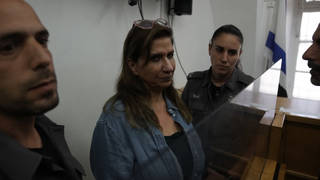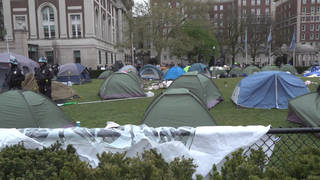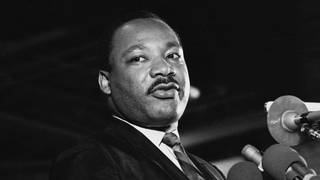
Related
Topics
Guests
- Barbara Smithauthor, activist and independent scholar. She is the founder of the Combahee River Collective and of Kitchen Table: Women of Color Press.
Since the police killing of George Floyd in May sparked a nationwide uprising against police brutality, armed white supremacists have taken to the streets of U.S. cities in response to Black Lives Matter protests. Organizing against systemic racism has been met with apparent attempts by the Trump administration to cover up white supremacist violence. We speak to legendary Black feminist scholar Barbara Smith, founder of the Combahee River Collective, about her proposal for an antiracist program called the Hamer-Baker Plan — named for Fannie Lou Hamer and Ella Baker — to eradicate white supremacy in the U.S. “I’m not just talking about white supremacist groups or organized white supremacy,” Smith says. “What I’m talking about is a system that actually dictates and shapes every aspect of life in the U.S.”
Transcript
AMY GOODMAN: This is Democracy Now! The Quarantine Report. I’m Amy Goodman, as we turn now from the cost of the so-called war on terror abroad to look at how the U.S. government is targeting Black Lives Matter protesters while downplaying the threat of white supremacist violence at home.
Since the police killing of George Floyd in May sparked a nationwide uprising against police brutality, armed white supremacists have taken to the streets of U.S. cities in response to Black Lives Matter protests. After the police shooting of unarmed Black father Jake Blake in Kenosha, Wisconsin, 17-year-old white Trump-supporting vigilante gunman Kyle Rittenhouse shot and killed two antiracist protesters in Kenosha last month. But President Trump has refused to criticize Rittenhouse. Just this week, Donald Trump Jr. said of the self-proclaimed vigilante, quote, “We all do stupid things at 17.”
On Wednesday, a Department of Homeland Security whistleblower accused the agency’s leadership of instructing analysts to downplay the violent threat posed by white supremacists. Brian Murphy, the former head of the Homeland Security Department’s intelligence branch, says he had been ordered to alter the text of assessments to make the threat of white supremacy, quote, “appear less severe.” Earlier this year, DHS drafted a document stating, quote, “white supremacist extremists will remain the most persistent and lethal threat in the Homeland through 2021.” That’s not a Black Lives Matter manual; again, that is DHS’s own words. But in newer versions of the document, the reference to white supremacists was removed. Murphy also claims leaders at DHS pressured analysts to change assessments to match up to comments made by President Trump attacking anti-fascist groups.
This comes as The Intercept reports in many states protesters who took part in the massive Black Lives Matter demonstrations are being charged with felonies, and even terrorism.
Well, for more, we’re joined by a guest who’s proposing a Marshall Plan to eradicate white supremacy in the United States. She calls it the Hamer-Baker Plan, for Fannie Lou Hamer and Ella Baker. Barbara Smith joins us now from Albany, New York, an author, activist, independent scholar, founder of the Combahee River Collective and of Kitchen Table: Women of Color Press. Her latest book, Ain’t Gonna Let Nobody Turn Me Around: Forty Years of Movement Building with Barbara Smith. Her recent piece for The Nation headlined “How to Dismantle White Supremacy.”
Barbara Smith, welcome back to Democracy Now! As we talk about terrorism, talk about what we see in the United States.
BARBARA SMITH: Well, thank you so much. It’s great to be with you again, Amy.
I actually was talking about something a bit different from what you just so very clearly framed in your introduction. I’m not just talking about white supremacist groups or organized white supremacy. What I’m talking about is a system that actually dictates and shapes every aspect of life in the United States, from where your kids go to school and what kind of education they’re able to get, what kind of housing you have, what your healthcare looks like, how often or much more often you die from COVID-19. I’m talking about the entire system. And I think that, of course, if we eradicate white supremacy and make that our priority and our goal, of course we’re going to get rid of the most extreme manifestations of white supremacy, which is organized white supremacist groups, violent terrorist groups. But I’m talking about something even, I think, larger.
AMY GOODMAN: So, talk about that larger picture, and talk about the plan that you see needs to be put in place in this country.
BARBARA SMITH: Well, I started writing about white supremacy earlier this summer, after George Floyd was lynched. I was so full of rage and pain, because I’ve been dealing with this ever since Emmett Till was lynched in 1955. I was 8 years old when that happened, so, of course, I could not fully understand what had actually transpired. I just knew that the people in my family, who were all from the Deep South — I grew up in Cleveland, Ohio, because they were part of the Great Migration — I just knew they were very, very upset about someone named Emmett Till, and that this person was also a child, like my twin sister Beverly and me. So, as I said, I’ve been dealing with this for quite a long time, 1955 until the spring of 2020 and beyond. So, I just thought, “I’ve got to write.” I’m a writer. I just thought, “I’ve got to write about this.”
What motivated me was the fact that when people were talking about these issues, either in print or in media, visual media, etc., that they never really talked about white supremacy. They would talk about race relations. They would talk about implicit bias. They would talk about needing to reform and change the culture of policing. All well and good, but they never talked about where all this mess comes from. And that’s what I wanted to write about.
In that first article, which appeared in The Boston Globe — it was an op-ed in The Boston Globe — I proposed: What would it be like if we had a Marshall Plan, or a plan on the scale of the space race, to eradicate white supremacy? And when I was in contact then with my editor at The Nation, they suggested, “Why don’t you spin that out?” And that’s where the second article evolved from.
AMY GOODMAN: And talk about Fannie Lou Hamer and Ella Baker, why you’ve named this plan after them.
BARBARA SMITH: Well, as I say when people ask me, it’s because I idolize them. And they are supreme examples of what being freedom fighters, principled, fearless — or at least courageous. There’s a difference between being fearless and being courageous. Courageous is actually better, because everyone should have some fear about what might actually harm them.
And, of course, Fannie Lou Hamer paid a huge price for wanting to do something as seemingly ordinary as vote. But in the Jim Crow South of that era, Black people, virtually none of them were allowed to vote. She paid a permanent price because of the beating that she received. And I just found out yesterday, if you can believe it, after all these years, that she actually was blinded in one eye. She is known for having worked with SNCC, doing voter organizing and other kinds of antiracist organizing during that Jim Crow era, and then, of course, speaking out so powerfully at the 1964 Democratic convention about what went on in Mississippi, and asking the very, very, very relevant question: “Is this America?”
And then, Ella Baker, of course, she was a person — among so many other things, she worked for all of the major civil rights organizations at some time. So she had experience across organizations. She also was doing that grassroots, very, very dangerous organizing in the Jim Crow South, in little towns, in rural areas. But she is probably best known for the person who inspired and made possible the founding of the Student Nonviolent Coordinating Committee, which is SNCC.
I actually had the great, great pleasure and honor of meeting Fannie Lou Hamer when I was a teenager in Cleveland in 1965 and was very involved in the civil rights movement as a young person.
AMY GOODMAN: Barbara Smith, can you talk about why you feel racial capitalism, and what you think that term means, should be at the center of this plan?
BARBARA SMITH: Well, as you know, Amy, you can’t talk about race in the United States without talking about class, and you can’t talk about class without talking about race. Racism, white supremacy, capitalism are absolutely intertwined. You know, it’s like a vine that has wrapped itself around a tree or another plant. What can you do to separate them? Very, very, very difficult to do.
We have and live under a system of racialized capitalism, where the worst consequences of capitalism fall upon those who have the least amount of white skin privilege — in other words, people of color. And that’s why we see such disproportionate economic results and consequences of that system. The fact that Black families have about 10% of the wealth, median wealth, of white families just says it all.
AMY GOODMAN: I want to go back to 1968, to the Kerner Commission, which offered a moment that could have launched the U.S. into a massive program to end white supremacy, but didn’t. Why do you think that didn’t happen during the civil rights movement? And what do you think is necessary to make this sort of national shift now?
BARBARA SMITH: Again, getting into the Wayback Machine of my memory and of my life, I remember when the Kerner Commission report came out. I remember buying my paperback copy. It was a best-selling book. And that’s when people had — you know, like, read paperbacks. You didn’t have the internet or all these other means of communication. So, the pocketbook, as they called them, the paperback book, that was the format.
And this was a big, thick, but small size, report done by a government bipartisan commission to explain — to investigate, explain, analyze why there had been so many urban insurrections, rebellions — I never call them “riots,” the other people can call them “riots” — but why there had been so many urban insurrections during that period of the late 1960s. And they came up with the incredibly insightful conclusion that it was white racism.
And I would say that the reason that it was not addressed at that time is because — and this may sound, you know, like, pessimistic, but it’s not; it’s just something for us to think about — this country functions with white supremacy as its engine, an engine that runs so many aspects — banking, healthcare, education. All these disparities that we see, it would take quite a bit to say, “I think, you know, we need to get rid of that.”
And that’s where we are now. Do we have the political will to actually eradicate white supremacy, or do we just want to kind of nip around the edges of it and do cosmetic things? You know? Taking down the Confederate statues, very, very important, very glad that’s happening, but it doesn’t necessarily get to the material conditions of people who live under this system, nor does it address the incredible violent racism that results in people like a Jacob Blake being shot seven times in front of his tiny children at point-blank range.
AMY GOODMAN: And as you speak, Barbara, it just so happens that in these seconds — people will hear it at different times, but at this time, 8:46, the first plane hit the first tower of the World Trade Center 19 years ago. I wanted to ask you about intersectionality, about taking on terrorism, taking on white supremacy. You say it can’t be divorced from misogyny and heteropatriarchy.
BARBARA SMITH: Right. Well, that’s, you know, certainly from my long years of commitment to fighting for women’s rights and women’s freedom, and also being an out lesbian since the 1970s. You know, like how on businesses they say things like “Serving you since 1942,” or whatever, well, if there was a little sign, you know, to explain that aspect of my life, it would be “Out lesbian since 1975.” So, that’s a long time, and that was not very long after Stonewall, so I’ve been involved in thinking about, organizing around, writing about issues of sexuality and gender, and sexuality and gender oppression, for decades, long before it was popular, long before it was considered to be cute. And I just approach everything that I work on and think about in that way.
And when you think about the issues of — the issue of white supremacy, it’s absolutely entwined — again, much like racial capitalism — it’s entwined with patriarchy and with homophobia and transphobia. So, you can’t really address one without the other. I mean, just like for a thought experiment, what would our country be like if we decided, miraculously decided, as a nation, to get rid of white supremacy in every possible way that we could, and left violence against women, rape, transphobia, homophobia, discrimination against people based upon gender and sexuality, if we left that intact? What would we have accomplished, if we do not look at all those vectors of oppression, all those roadblocks to freedom?
And there are many other things, you know, that we can talk about, too. We have to look at our international situation. We have to look at our relationship to the rest of the world. We export white supremacy. Your previous guest was talking about the incredible repercussions of the United States’ ongoing so-called foreign policy, which is really war policy, and that, I think he said, there were only 11 years in the entire history of the country when we weren’t involved in warfare. What does that say about what kind of nation we are? And so much of that has been racialized. And particularly, you know, I would say, since World War II, the skirmishes, and not — I mean, they’re bigger than skirmishes — the military adventures that this nation engages in just always seems to be against populations of people of color. We could talk about disability —
AMY GOODMAN: Barbara, before we go, since we just have 30 seconds, I want to ask —
BARBARA SMITH: Yes. I’m sorry.
AMY GOODMAN: — if you see echoes of the Hamer-Baker Plan in the Democratic Party platform, or what’s being put forth, in the role you see activists should play in the November election?
BARBARA SMITH: I haven’t read the platform, but from what I gather, it’s coming from a different place, because as — I talked about nipping around the edges of the problem. I think that even if they’re bold initiatives, you have to have the consciousness. You have to acknowledge and admit that white supremacy exists, in order to fight it. And, see, that’s the difference. There may very well be things in that platform that will help with our racial — our situation of vast racial inequality. But is the purpose of those initiatives to address that bedrock system of white supremacy? That’s the difference, and that’s why I proposed the Hamer-Baker Plan.
AMY GOODMAN: Well, we’re going to link to that plan at democracynow.org. Barbara Smith, author, activist and independent scholar. Her piece in The Nation, “How to Dismantle White Supremacy.”
When we come back, as global deaths from COVID-19 start to near 1 million, we look at the race to develop a vaccine and the issue of transparency. Back in 30 seconds.












Media Options